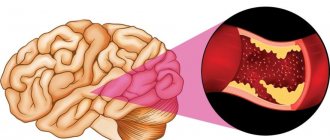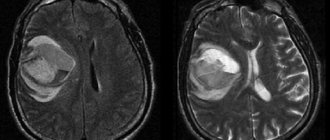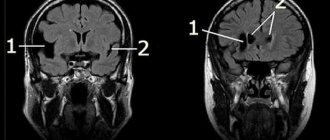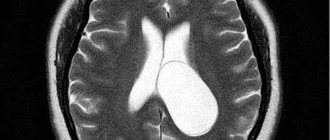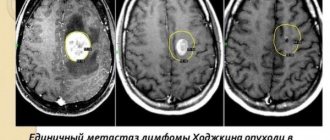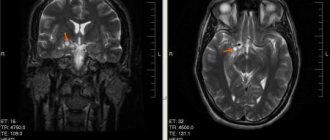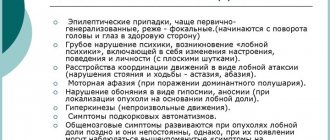Rathke's pouch cyst - what is it?
Rathke's pouch cyst is a cystoid formation that occurs in the brain. In an ordinary person, at the time of his birth, Rathke's pouch is not observed, but there are groups of people in whom fragments of this structure remain.
The formation of a cyst occurs by filling this pocket with colloid. The sizes and shapes of this formation may vary. Cases of such cysts have been recorded, with a volume ranging from a few millimeters to larger ones of several centimeters. The shape of the formation is usually oval or round .
Rathke's pouch cyst almost always localized If you are interested in the answer to the question that this is the pituitary gland, then read our similar article.
Most often, the formation does not manifest itself in any way until it reaches a significant size, beginning to compress nearby tissues, the pituitary gland itself, the optic nerves and other structures. The pituitary gland is the most important component of the entire body. This part of the brain produces hormones that are responsible for many body functions.
Pituitary hormones:
- Corticotropin
- A growth hormone
- Thyrotropin
- Follitropin
- Prolactin
- Lipotropin
- Lutropin
Failure in the production of so many different hormones can lead to disruption of the entire body. That is why a Rathke's pouch cyst can provoke any pathological processes in the human body.
You can find information about other types of brain cysts here.
Elimination of Rathke's pouch cyst: in which cases treatment is not required
If the cyst does not cause discomfort and was discovered during the examination, does not have a tendency to grow, and does not provoke complications, then treatment is not required. However, it is worth undergoing regular examinations with doctors, including a neurosurgeon.
In such cases, the cyst does not manifest itself for many years, sometimes throughout life. Occasionally there are situations when it disappears due to the absorption of contents against the background of reduced secretion. You should not hope to get rid of the cyst without intervention - the process is complex and does not produce results in all cases, especially considering the location of the formation.
The cyst is in the brain, under pressure, without the ability to influence it non-surgically. This means that absorption cannot be stimulated. In the process of monitoring whether the cyst resolves, it is possible to allow the development of more severe symptoms, which will lead to the formation of a tumor and severe pain in the patient.
Is it dangerous?
One of the most serious dangers that awaits patients diagnosed with Rathke's pouch cyst is a malfunction of the pituitary gland . In the case when the cystic formation compresses the pituitary gland itself, the production of hormones is disrupted. This situation is fraught with many health problems and can lead to dire consequences.
What threatens hormonal imbalance:
- Hypothyroidism
- Growth hormone deficiency (dwarfism)
- Diabetes insipidus
- Hypopituitarism (serious metabolic disorders)
- Infertility, menstrual irregularities and breast swelling in women
- Impotence and decreased libido in men
- Acromegaly
- Impaired functioning of all organs and systems
- Osteoporosis
- Diabetes
- Obesity
- High blood pressure
The pituitary gland is responsible for many parts of the body, so its good functioning is a necessity. If a child has a large Rathke's pouch cyst, the baby's development will be disrupted, with many abnormalities and pathologies.
Symptoms
The disease is often asymptomatic. Especially in cases where the cystic formation is small and not prone to further growth. Characteristic symptoms appear when the cyst grows and begins to compress the structures located next to Rathke's pouch - the pituitary gland, chiasm (chiasm) of the optic nerves, cavernous (cavernous) sinus. Compression of brain tissue is accompanied by persistent headache (in 81% of cases) and visual dysfunction (75% of cases). In 81% of cases, this diagnosis is manifested by disturbances in the functioning of the endocrine system. Typical hormonal imbalances:
- Hypopituitarism (deficiency of pituitary hormones). In 60% of cases, hypogonadotropic hypogonadism develops (decreased production of androgens - male sex hormones), in 36% of cases - secondary adrenal insufficiency, in 36% of cases - secondary hypothyroidism (deficiency of thyroxine and triiodothyronine with subsequent metabolic disorders), in 12-79% cases – lack of somatotropin (growth hormone).
- Hyperprolactinemia. The condition is caused by compression of the pituitary stalk and disruption of the transport of the hormone dopamine. Manifested by a moderate increase in prolactin concentration. If the level of prolactin increases significantly, there is a high probability of a combination of a cyst and prolactinoma, which is often detected after surgery and examination of a histological sample.
- Water and electrolyte disorders.
- Antidiuretic hormone (ADH) deficiency.
Cystic formation is accompanied by the development of diabetes insipidus in 3-19% of cases. Sometimes the clinical picture is supplemented by apoplexy (bleeding) of the pituitary gland or hemorrhage into the cystic cavity. Both conditions provoke an acute deterioration in neurological status and the appearance of symptoms:
- Attacks of nausea accompanied by vomiting.
- Intense pain in the head, difficult to relieve.
- Visual impairment.
The following factors can provoke the appearance of a cystic cavity: previous viral and bacterial infections, hypoxia (oxygen starvation) of brain tissue, chronic intoxication, ionizing radiation, birth injuries received by a newborn.
How is it formed?
Fetal development is a complex process. It is during this period that the body of the future person is formed. Rathke's pouch is an anatomical structure that begins in the womb for everyone. From this structure the pituitary gland of the brain, its anterior and posterior walls, as well as the necessary funnel are later formed. At the end of this process, the pocket itself disappears.
If a failure occurs in the creation of such a structure, these building cells remain and continue their work, creating a cavity located in the pituitary gland itself. Over some time, the resulting pocket begins to fill with mucoid epithelium with an admixture of desquamated contents.
The usual size of this benign non-tumor formation is about two centimeters , but there are cases when the cyst grows to large sizes.
Anatomy of Rathke's pouch
Formations of a cystic structure are formed in any organs and systems. The degree of danger of the pathology and the consequences for the patient depend on the location and nature.
Rathke's pouch is a normal anatomical structure found in humans. The scientific name is the pituitary tract. The brain is the site of formation of this structure. It is formed in the area of the sella turcica in the early stages of development in the mother’s body. As a result, two parts of the pituitary gland, the most important organ of the endocrine system, are formed from this structure. The adenohypophysis and neurohypophysis are formed, located in the anterior and posterior parts of the pituitary gland.
In the later stages, provided that the fetus develops normally, the pocket overgrows and remains in the form of a connective tissue cord. If infection does not occur, a lumen is formed, which is filled with colloidal contents and forms a cyst. The cyst grows by 5-6 centimeters. There are microcysts several millimeters in size, which may subsequently increase or remain unchanged in size.
The internal filling of the cystic cavity is a jelly-like, serous or mucous fluid. In histological materials, examination reveals exfoliation of epithelial cells. If it turns out that active internal secretion is present, the contents increase in volume, stretch the walls of the cyst, and compress the adjacent tissues. This causes discomfort to the patient and can cause complications if treatment is not timely or if postoperative care is improper.
Risk group
The reasons for the manifestation of this pathology have not yet been precisely identified, but, according to doctors, there are certain people who are at risk for this disease.
Provocative effects:
- Hereditary predisposition
- Infectious impact
- Viral diseases during pregnancy
- Inflammatory processes
- Fetal hypoxia
- Taking certain medications
- Work in hazardous industries
- Exposure to exposure and radiation
- Prolonged exposure to ultraviolet rays
- Childbirth with complications
Rathke's pouch cyst is very rare, occurring in 1% of all benign tumors. Sometimes this disease can be present in a person all his life and not make itself felt, without developing, and under certain circumstances begin to grow.
People at risk:
- Elderly people, because often the growth of education begins after 40 years.
- Previously ill with meningitis.
- Patients who have suffered a stroke, which was accompanied by cerebral hemorrhage.
- Those who have had encephalitis.
- Workers in hazardous and toxic industries.
- Patients after chemotherapy and radiation.
- Everyone who has had this pathology or other types of brain tumors in their family.
Signs
not manifest itself for a long time and may be asymptomatic. Many people find out about the presence of this formation by chance, having undergone MRI diagnostics. Problems arise when the formation for some reason begins to grow, increasing in size and squeezing all surrounding tissues.
Symptoms:
- Insomnia
- Dizziness
- The appearance of hallucinations
- Intense headache of increasing character
- Visual impairment
- Epileptic seizures
- Hyperesthesia of intracranial flow
- Nausea, vomiting
- Rumbling in ears
- Loss of coordination
- Fainting and confusion
- Mental disorder
- Memory deterioration up to blackouts
- Fine motor disorder
- Endocrine system diseases
The manifestation of symptoms directly depends on the size of the cyst and its pressure on the pituitary gland, other nearby areas and nerve endings.
In addition, due to an increase in education, other disorders may occur caused by a failure of blood circulation in the brain, such as:
- difficulty in the outflow of liquor fluid;
- deterioration in the functioning of the brain structure and others.
In another article from our website we raise the issue of retrocerebellar cyst of the brain.
Possible complications
Rathke's pouch cyst itself is not dangerous.
There are serious concerns about:
- The rapid growth of this formation . In some cases, the patient may completely lose vision, show signs of mental abnormalities, and then a clinical picture of destruction of the pituitary gland will appear. All these situations are possible due to the growth of the cyst.
- A serious complication is the degeneration of the formation into a tumor. In case of benign degeneration, treatment can stop the growth of the tumor.
- It happens that this pathology degenerates into a malignant formation , then the prognosis of the disease becomes extremely unfavorable.
Cases of transformation of such a cyst are extremely rare ; usually the disease is at one stage of development.
What to do if a cyst is found during pregnancy?
A woman undergoes many different examinations during pregnancy. In some cases, diagnostic measures reveal diseases in such patients that they were not aware of.
The diagnosis of Rathke's pouch cyst , made for the first time, can unsettle, especially if this pathology is discovered in a pregnant woman. This disease is not a death sentence for pregnant women, but the entire period of gestation must be constantly consulted with a doctor.
The fact is that cysts of any organs can begin to grow during pregnancy, provoked by hormonal changes in the woman’s body. In rare cases, cyst growth still occurs during such a difficult period, and this factor causes many problems with the development and gestation of the fetus.
The large size of the formation disrupts blood circulation in the brain and negatively affects the functioning of the pituitary gland, which is fraught with hormonal imbalance. Good functioning of the hormonal system is especially important for pregnant women, because only with normal levels of hormones is the correct development of the fetus possible.
It is the growth of education provoked by pregnancy that is very dangerous, both for the expectant mother and for her baby. Only a doctor can prescribe medications or measures to control the growth of the cyst.
What does it look like?
This is a benign formation. It looks like a pea or a grain of rice - dense tissue of a round or oval shape, clearly demarcated from the substance of the pituitary gland. An asymptomatic Rathke's pouch cyst ranges in size from 1 mm to 2 cm, and at these sizes it does not interfere with brain function in any way. In the vast majority of cases, it is located between the anterior and posterior lobes of the pituitary gland, sometimes in front of the infundibulum. The formation is elastic, the structure is mucous (synovial, jelly-like). Sometimes serous fluid or desquamated cells are found inside the cyst.
During life, this cyst is rarely detected, only if it becomes hormonally active or excessively large and begins to put pressure on the surrounding nerve structures. At autopsies it is detected in 22% of cases, and in women it is 2 times more likely.
Manifestation of pathology
In a child or adult, the cyst may enlarge and put pressure on neighboring structures:
- pituitary gland as a whole;
- cavernous sinus or cavernous sinus, through which venous blood flows from the eye sockets and brain;
- chiasma or optic chiasm.
The first symptom is headache. The skull is a closed space that does not expand. The excess volume inside the head puts pressure on the brain, swelling immediately increases, which increases the pressure even more.
Visual impairments are added - loss of fields, decreased sharpness, double vision, impaired color perception. As the cyst grows, these disturbances increase.
Another dangerous sign of a cyst is pituitary dysfunction, which includes:
- An increase in the blood level of the hormone prolactin. The disorders are diverse, and each person’s case is different from the other. Young women may experience absence of menstruation combined with leakage of milk from the mammary glands and infertility. Women of all ages experience menstrual irregularities. It is believed that a third of cases of female infertility are caused by hyperprolactinemia, as this condition is correctly called. Other signs in women are loss of sexual feeling, male-type body hair, low timbre of voice, growth of mustache and beard. In men, this condition leads to the deposition of fat on the hips and buttocks according to the female type, the growth of the mammary glands, an increase in the timbre of the voice, a decrease in hair, as well as erectile dysfunction. People of both sexes suffer from obesity in combination with diabetes mellitus and decreased bone mineral density.
- Growth hormone deficiency. This danger awaits children; they may remain abnormally short forever.
- Decreased levels of the hormone cortisol. This is a stress hormone produced by the adrenal glands, but the pituitary gland “commands” its synthesis. This can manifest itself as a drop in blood sugar, loss of appetite and weight, muscle weakness and fatigue, decrease in blood pressure, calcium and potassium levels.
- Hypogonadism or decreased production of sex hormones by the testicles in men.
- Diabetes insipidus or diabetes insipidus is a condition that affects young people and even children in the first year of life. A person suffers from excessive thirst, constantly drinks water, excreting from 6 to 15 liters of urine per day.
A Rathke's pouch cyst can remain of acceptable size, remain small, but at some point become hormonally active. Then it begins to pose a danger, the person is tormented by the manifestations described above.
Diagnostics
If certain symptoms occur that give rise to suspicion of the presence of a Rathke's pouch cyst, you first need to see a specialist. Endocrinologist is the first doctor who is able to identify this disease.
Sometimes consultation with other doctors is required to clarify the clinical picture of the disease. To more accurately determine the presence of this formation and its size, modern diagnostic methods are used.
Methods:
- Magnetic resonance imaging . It is believed that this research method is the most informative. MRI images will tell you about the location, size and other features of the cyst.
- CT scan . Using CT, specialists recognize calcification, a process that indicates the degeneration of a cyst into a craniopharyngioma.
- Angiography . This diagnostic method will determine the condition of the brain vessels and the possibilities of their functioning.
Methods of treating pathology
If the Rathke's pouch cyst is asymptomatic and does not increase in size, then the patient does not need treatment ; it is only necessary to regularly examine the formation to control its size. With minor signs of this pathology, the doctor prescribes treatment with hormones, which are selected strictly individually for each patient.
If Rathke's pouch cyst grows rapidly, more serious treatment is required. The first stage of therapy consists of taking hormonal drugs, they should stop this process. If the hormones have not coped with their task, surgical treatment .
There are two types of surgery used today:
- Classic operation . During surgery, the doctor removes the cyst through an incision in the turbinate area. Rathke's pouch can only be reached through the sphenoid sinus. For good visibility, the surgeon uses a binocular microscope.
- Laparoscopy . This surgical method is very popular. Using an endoscope, the surgeon enters the skull through the nose, completely removing the formation. With this removal, the vessels of the brain and the pituitary gland itself are not injured.
Only surgical treatment of Rathke's pouch cyst can completely rid a person of this disease.
After the operation, the contents of the cyst are sent for analysis to exclude a malignant course of the process.
Complications in case of refusal of treatment
Complications vary. The main ones are:
- Rapid growth of the cyst, which leads to impaired or occasionally loss of vision, mental problems, and destruction of the pituitary gland.
- The most difficult and unfavorable complication is a malignant tumor. Treatment will be much more labor-intensive and lengthy.
As a result of the formation of a cyst in the area of Rathke's pouch, hormonal imbalance may occur, which leads to malfunctions of all organs and systems.
Often, with a timely visit to the hospital and proper treatment, a Rathke's pouch cyst can be treated and does not cause discomfort in the future. The recovery rate is not 100%. A failure of this type in the human body can lead to complications including disability. Therefore, the decision on the method of treatment is made by the doctor based on an assessment of the risks and benefits for the patient.
Consequences
In order for Rathke's pouch cyst to cause as few problems as possible, you need to constantly consult with your doctor. With timely and adequate treatment, you can not be afraid of the occurrence of severe symptoms of this disease.
Most likely, patients are prescribed surgery to remove the formation, which guarantees a complete recovery. 100%.
Even the most insignificant symptoms of this disease cannot be ignored, because they can increase, and the processes of disturbances in the body will become irreversible. To exclude any diseases, you need to undergo regular examinations in medical institutions, this will allow you to identify all ailments and begin treatment on time.
03.10.2016
